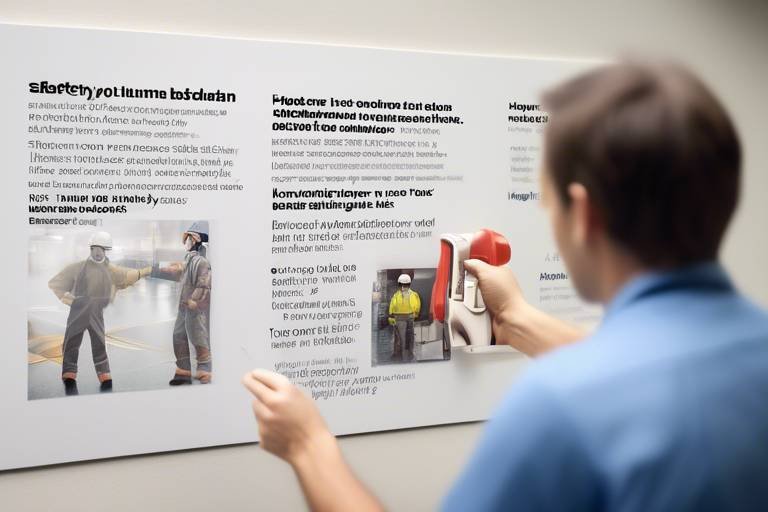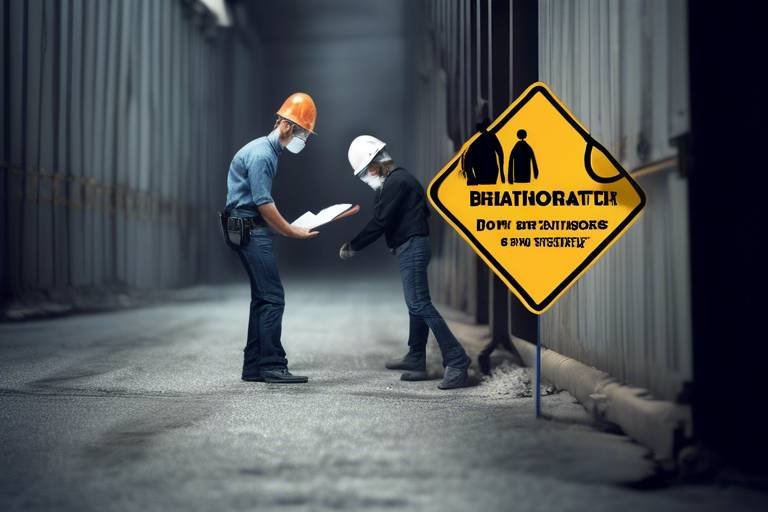Human Behavior and Its Influence on Safety Strategies
In today's world, safety is not just a priority; it's a necessity. Whether in the workplace, at home, or in public spaces, understanding human behavior is crucial in crafting effective safety strategies. The intricate dance between our actions and the environments we navigate can determine the success or failure of safety protocols. Have you ever wondered why some people take risks despite clear warnings? Or why certain safety measures are ignored? These questions lead us to explore the psychological factors that shape our perception of risk and the decisions we make in potentially hazardous situations.
At the heart of safety strategies lies the understanding that human behavior is often unpredictable and influenced by numerous factors. From cognitive biases to emotional responses, our decisions are rarely made in a vacuum. For instance, consider the difference between knowing something is dangerous and actually feeling that danger. This emotional disconnect can lead to poor decision-making, which is why safety strategies must account for the human element. By delving into the psychology of risk perception, we can identify ways to better align safety measures with how people think and behave.
Moreover, implementing effective safety strategies requires a comprehensive approach that includes training and awareness. It’s not enough to simply inform people about risks; we need to engage them in a way that resonates with their values and experiences. This involves creating an environment where safety is not just a set of rules but a shared responsibility. When individuals feel personally invested in safety, they are more likely to adhere to guidelines and promote a culture of safety within their communities.
In summary, the interplay between human behavior and safety strategies is complex yet fascinating. By understanding the psychological underpinnings of our actions, we can develop more effective safety protocols that resonate with individuals on a deeper level. This exploration into human behavior not only enhances safety measures but also fosters a culture where safety becomes a collective priority.
Understanding how individuals perceive risk is crucial for developing effective safety strategies. This section delves into the psychological factors that influence risk assessment and decision-making in potentially hazardous situations.
Behavioral economics provides insights into how people make decisions regarding safety. This section examines the cognitive biases that can lead to unsafe choices and how to counteract them through better safety protocols.
Incentives can significantly affect behavior related to safety. This subheading discusses how financial and non-financial rewards can motivate individuals to adhere to safety guidelines and practices effectively.
Implementing positive reinforcement techniques can enhance compliance with safety measures. This section explores various methods to encourage safe behavior through recognition and rewards.
While incentives can be beneficial, they can also backfire if not designed carefully. This part discusses the potential pitfalls and unintended consequences of incentive-based safety strategies.
Effective training and awareness programs are vital in shaping safe behavior. This section covers best practices for designing and implementing programs that promote safety consciousness among employees and the community.
Organizational culture plays a significant role in shaping safety behaviors. This section analyzes how a strong safety culture can lead to improved compliance and reduced incidents in the workplace.
Leadership commitment is essential for fostering a safety-oriented culture. This subheading explores how leaders can influence safety behaviors through their actions and communication.
Engaging employees in safety practices enhances their commitment to safety protocols. This section discusses strategies for involving staff in safety initiatives and decision-making processes.
- What are the main factors influencing human behavior in safety?
Human behavior is influenced by psychological factors, cognitive biases, emotional responses, and the organizational culture surrounding safety. - How can training improve safety awareness?
Training programs can enhance safety awareness by providing knowledge, developing skills, and fostering a culture of safety through engagement and participation. - What role do incentives play in safety compliance?
Incentives can motivate individuals to follow safety guidelines, but they must be designed carefully to avoid unintended consequences. - How can organizations build a strong safety culture?
Organizations can build a strong safety culture by promoting leadership commitment, engaging employees, and continuously improving safety practices and protocols.

The Psychology of Risk Perception
Understanding how individuals perceive risk is crucial for developing effective safety strategies. Risk perception is not merely a reflection of actual danger; it is a complex interplay of psychological factors, personal experiences, and social influences. Imagine walking across a busy street. For some, the rush of traffic may seem exhilarating, while for others, it may evoke a sense of dread. This difference in perception can significantly impact decision-making in potentially hazardous situations. So, what drives these varying perceptions?
One major factor is cognitive biases. These mental shortcuts can lead us to overestimate or underestimate risks based on our emotions or past experiences rather than actual data. For instance, someone who has never experienced a workplace accident may perceive their environment as entirely safe, while another who has witnessed an incident may be overly cautious. This phenomenon illustrates how our brains can play tricks on us, skewing our understanding of risk.
Moreover, societal influences play a significant role in shaping our risk perceptions. We often look to others when assessing danger. If our peers engage in risky behaviors—like ignoring safety protocols—we may feel inclined to follow suit, believing that if they aren’t worried, we shouldn’t be either. This herd mentality can create a false sense of security, leading to unsafe choices.
Another interesting aspect is how emotional responses can cloud judgment. When faced with a potential threat, our instinctual reactions may override rational thinking. For example, during an emergency, fear can lead to panic, causing individuals to make hasty decisions that compromise safety. Understanding these emotional triggers can help in designing better safety strategies that account for human behavior.
To effectively address these psychological factors, it’s essential to incorporate training and awareness programs that educate individuals about risk perception. By fostering a culture of open communication about risks and encouraging employees to share their experiences, organizations can create an environment that promotes safer decision-making. Here are some strategies to enhance risk perception:
- Education: Providing training sessions that focus on understanding risks and safe practices.
- Open Dialogue: Encouraging discussions about safety concerns and personal experiences.
- Scenario-Based Learning: Using simulations to help individuals experience and assess risks in a controlled environment.
In conclusion, the psychology of risk perception is a multifaceted issue that significantly influences safety strategies. By acknowledging the psychological factors at play, organizations can tailor their safety protocols to better align with human behavior. Understanding that individuals do not always act rationally when it comes to risk can lead to more effective training programs and ultimately, a safer environment for everyone.
1. What is risk perception?
Risk perception refers to the subjective judgment that individuals make regarding the characteristics and severity of a risk. It is influenced by various psychological and social factors.
2. How do cognitive biases affect safety decisions?
Cognitive biases can lead individuals to misjudge risks, often resulting in unsafe choices. For example, overconfidence in one's abilities may cause someone to disregard safety protocols.
3. Why is emotional response important in risk perception?
Emotional responses can significantly impact decision-making during risky situations, often leading to panic or irrational behavior that compromises safety.
4. How can organizations improve risk perception among employees?
Organizations can improve risk perception by implementing training programs, encouraging open dialogue about safety concerns, and using scenario-based learning to simulate real-life situations.

Behavioral Economics and Safety Decisions
When we think about safety, it’s easy to assume that people make rational choices based on the information available to them. However, the reality is much more complex. Behavioral economics delves into the psychological factors that influence our decision-making processes, revealing that our choices are often swayed by cognitive biases and emotional responses. This understanding is crucial for developing effective safety strategies that resonate with individuals in real-world scenarios.
For example, consider the concept of loss aversion, which suggests that people are more motivated to avoid losses than to achieve equivalent gains. This can manifest in safety decisions where individuals might disregard safety protocols if they perceive them as inconvenient or unnecessary, even if the potential risks are significant. It's like choosing to skip wearing a seatbelt because it feels restrictive, despite knowing that it could save your life in an accident.
Another important aspect is the availability heuristic, where people judge the likelihood of an event based on how easily examples come to mind. If someone has never witnessed a workplace accident, they might underestimate the potential risks involved in their daily tasks. This cognitive bias can lead to a false sense of security and, ultimately, unsafe behavior. To counteract this, safety campaigns should include real-life stories and data that highlight the consequences of neglecting safety measures, making the risks more tangible and relatable.
To further illustrate how behavioral economics influences safety decisions, let’s look at a few common cognitive biases:
- Confirmation Bias: Individuals may focus on information that supports their existing beliefs about safety, ignoring evidence that contradicts them.
- Optimism Bias: Many people believe that bad things are less likely to happen to them than to others, leading to complacency regarding safety protocols.
- Framing Effect: The way safety information is presented can significantly influence decisions. For instance, emphasizing the benefits of following safety guidelines rather than the risks of not doing so can lead to better compliance.
Understanding these biases allows organizations to tailor their safety strategies effectively. By incorporating insights from behavioral economics, companies can design interventions that not only inform but also motivate individuals to prioritize safety. For instance, implementing nudges—small changes in the environment or the way choices are presented—can lead to safer behaviors without restricting freedom of choice. A simple reminder to wear personal protective equipment (PPE) at the entry points of hazardous areas can go a long way in improving compliance.
Moreover, organizations can enhance their safety protocols by integrating behavioral insights into training programs. This could involve role-playing scenarios where employees confront safety dilemmas, helping them recognize their biases and learn how to make better decisions in the face of risks. By fostering an environment where open discussions about safety are encouraged, employees are more likely to engage with safety protocols actively.
In conclusion, leveraging the principles of behavioral economics is essential for shaping effective safety decisions. By understanding the psychological factors that influence human behavior, organizations can create a culture of safety that not only promotes compliance but also empowers individuals to take ownership of their safety and that of their colleagues. Ultimately, this leads to a safer workplace where everyone feels responsible for maintaining a secure environment.

The Role of Incentives
Incentives play a crucial role in shaping behaviors related to safety, acting as motivators that can either encourage or discourage adherence to safety practices. Think of incentives as the carrots that dangle in front of us, urging us to take the right path. When designed effectively, they can create a culture of safety where individuals feel compelled to follow guidelines and protocols. But what exactly makes an incentive effective? It all boils down to understanding what drives people.
Financial incentives, such as bonuses or pay raises, are often the first that come to mind. However, non-financial rewards can be just as powerful. Recognition, praise, and a simple 'thank you' can go a long way in making employees feel valued and appreciated for their commitment to safety. The key is to align these incentives with the specific safety goals of the organization. For instance, if the aim is to reduce workplace accidents, offering rewards for teams that achieve safety milestones can foster a sense of competition and camaraderie.
Moreover, it's essential to ensure that the incentives are perceived as attainable and fair. If employees feel that the goals set for them are unrealistic, they may become disheartened and disengaged. This is where communication comes into play. Clearly outlining the criteria for earning incentives can help in managing expectations and motivating employees to strive for safety compliance. Here are some examples of effective incentive structures:
- Safety Awards: Monthly or quarterly awards for individuals or teams who demonstrate exceptional safety practices.
- Recognition Programs: Public acknowledgment in company meetings or newsletters for those who consistently adhere to safety protocols.
- Team-Based Incentives: Group rewards for teams that meet safety targets, promoting teamwork and collective responsibility.
However, it’s important to tread carefully when implementing incentive programs. If not designed thoughtfully, they can lead to unintended consequences. For instance, if employees are rewarded solely for meeting safety targets, they might start to cut corners or overlook minor safety violations just to secure their bonuses. This is why it’s crucial to balance incentives with a strong emphasis on ethical behavior and genuine safety compliance.
In conclusion, while incentives can significantly enhance safety behaviors, they must be part of a well-rounded strategy that includes clear communication, realistic goals, and ongoing support. When employees feel genuinely motivated and recognized for their efforts, the result is a safer and more productive work environment. So, as organizations strive to improve safety, they should consider how to best harness the power of incentives to create a culture that values and prioritizes safety above all else.

Positive Reinforcement Techniques
When it comes to encouraging safe behavior in any environment, can be game-changers. Imagine a workplace where employees not only follow safety protocols but do so with enthusiasm and commitment. This is the power of positive reinforcement! By recognizing and rewarding safe behaviors, organizations can create a culture where safety isn't just a requirement—it's a shared value. But how exactly can this be achieved?
First off, it’s essential to understand that positive reinforcement isn’t just about handing out rewards like candy. It’s about creating a system where safe actions are acknowledged and celebrated. For instance, consider implementing a recognition program that highlights individuals or teams who consistently adhere to safety guidelines. This could be as simple as a monthly safety award or a shout-out in a company newsletter. Such recognition serves as a powerful motivator, encouraging others to follow suit.
Moreover, the types of rewards can vary widely, appealing to different preferences among employees. Some may appreciate monetary bonuses, while others might find value in non-financial rewards such as extra time off, gift cards, or even public acknowledgment in front of peers. The key is to tailor the reinforcement to what resonates most with your team. Here’s a quick table to illustrate some effective positive reinforcement strategies:
| Reinforcement Type | Description | Example |
|---|---|---|
| Monetary Rewards | Financial incentives for safe behavior | Bonuses for zero accidents in a quarter |
| Recognition Programs | Acknowledging individuals or teams publicly | Employee of the Month for safety adherence |
| Team Celebrations | Celebrating collective achievements | Team lunch for meeting safety targets |
In addition to rewards, feedback is an essential component of positive reinforcement. When employees receive constructive feedback regarding their safety practices, it reinforces their understanding of what they are doing right and where they can improve. Regular check-ins and safety meetings can provide a platform for this feedback, ensuring that safety remains a top priority in everyone’s mind.
However, it’s crucial to ensure that the reinforcement strategies are applied consistently and fairly. If employees perceive that rewards are given arbitrarily or that certain individuals are favored, it can lead to resentment and disengagement. To prevent this, organizations should establish clear criteria for recognition and ensure that everyone has an equal opportunity to be rewarded for their safe behaviors.
Ultimately, the goal of positive reinforcement techniques is to create a sustainable culture of safety. By fostering an environment where safe practices are celebrated, organizations can not only reduce incidents but also enhance overall employee morale. It's about building a community where safety is a shared responsibility and everyone feels valued for their contributions.
- What are positive reinforcement techniques? These are strategies used to encourage specific behaviors by providing rewards or recognition for those behaviors.
- How can positive reinforcement improve safety? By acknowledging and rewarding safe behavior, employees are more likely to continue those practices, leading to a safer workplace.
- What types of rewards work best? Rewards can be monetary, such as bonuses, or non-monetary, like public recognition or extra time off. Tailoring rewards to employee preferences is key.
- How can feedback be integrated into positive reinforcement? Regular feedback sessions can help reinforce safe behaviors and provide guidance on improvements, making safety a continuous dialogue.

Potential Pitfalls of Incentives
While incentives can be a powerful tool in promoting safety behaviors, they are not without their potential pitfalls. When not designed thoughtfully, incentive programs can lead to unintended consequences that may actually compromise safety rather than enhance it. For instance, if the focus is solely on meeting specific safety targets, employees may feel pressured to overlook minor safety violations just to achieve the reward. This creates a dangerous culture where the end justifies the means, undermining the very purpose of the safety protocols in place.
Moreover, incentives can sometimes lead to a short-term mindset. Employees might engage in safe practices only to secure a reward, but once the incentive is removed, their commitment to safety may wane. This phenomenon is akin to a child who cleans their room only to earn a cookie; once the cookie is gone, the motivation to keep the room tidy diminishes. To mitigate this, organizations must ensure that safety becomes a core value rather than a transactional activity.
Another significant concern is the issue of fairness and transparency. If employees perceive the incentive program as biased or unfair, it can lead to resentment and disengagement. For example, if only certain teams or individuals consistently receive rewards, others may feel demotivated, believing their efforts are not recognized. This can create a toxic atmosphere that stifles collaboration and teamwork, which are essential for a robust safety culture.
Furthermore, the type of incentives offered can also impact their effectiveness. While financial rewards may seem attractive, they can sometimes overshadow intrinsic motivations for safe behavior. Employees might start to view safety as a means to an end rather than a critical aspect of their job. This is where positive reinforcement techniques come into play. Instead of solely relying on monetary incentives, organizations should consider a balanced approach that includes recognition and appreciation for safe behaviors, fostering a more holistic commitment to safety.
In conclusion, while incentives can indeed motivate individuals to adhere to safety guidelines, organizations must tread carefully. It is essential to design incentive programs that promote a culture of safety, focusing on long-term behavioral change rather than short-term compliance. By addressing these potential pitfalls, organizations can create a safer environment that prioritizes the well-being of all employees.
- What are the most common pitfalls of safety incentives? Incentives can lead to short-term compliance, perceptions of unfairness, and a focus on rewards over intrinsic safety values.
- How can organizations ensure their incentive programs are effective? By focusing on long-term behavioral change, involving employees in the design process, and balancing monetary rewards with recognition.
- What role does organizational culture play in safety incentives? A strong safety culture enhances the effectiveness of incentives by aligning them with core values and promoting collective responsibility.

Training and Awareness Programs
When it comes to fostering a safe environment, effective training and awareness programs are absolutely essential. These programs serve as the backbone of safety strategies, ensuring that individuals not only understand the risks involved but also know how to mitigate them. Imagine walking into a workplace where every employee is not just aware of the safety protocols but actively practices them—this is the kind of culture that robust training programs can create.
One of the key elements of successful training is its relevance. Programs must be tailored to the specific risks associated with a given environment. For example, a construction site will have vastly different safety concerns compared to an office setting. By customizing training to address these unique challenges, organizations can ensure that their employees are not just going through the motions but are genuinely engaged in the learning process.
Moreover, the delivery method of training can significantly influence its effectiveness. Traditional classroom settings have their place, but incorporating interactive elements such as simulations, role-playing, and hands-on activities can enhance retention and understanding. For instance, using virtual reality (VR) technology to simulate hazardous situations allows employees to experience potential dangers in a controlled environment, making them better prepared for real-life scenarios.
In addition to the initial training, ongoing education is crucial. Safety is not a one-time lesson but a continuous journey. Regular refreshers and updates on new safety protocols keep the information fresh and relevant. Employers can implement a schedule that includes quarterly training sessions, ensuring that safety remains a priority. A
| Training Frequency | Training Content | Duration |
|---|---|---|
| Quarterly | Safety Protocol Updates | 2 hours |
| Bi-Annually | Emergency Response Drills | 3 hours |
| Annually | Comprehensive Safety Review | 4 hours |
Another critical aspect of training programs is the emphasis on awareness. Employees should not only be trained on specific procedures but also understand the broader implications of safety in the workplace. Awareness campaigns, which can include posters, newsletters, and workshops, can reinforce the importance of safety and keep it at the forefront of employees' minds. When individuals are aware of the potential consequences of unsafe behavior, they are more likely to act responsibly.
Furthermore, fostering an environment where employees feel comfortable reporting unsafe conditions or behaviors is vital. Training should include information on how to communicate safety concerns effectively. This not only empowers employees but also helps organizations identify and rectify issues before they escalate into serious incidents. After all, safety is a collective responsibility, and everyone plays a role in maintaining it.
Finally, the effectiveness of training and awareness programs can be measured through feedback and performance metrics. Organizations should implement methods to gather feedback from participants, which can provide valuable insights into the training's impact. Surveys, quizzes, or even informal discussions can help gauge understanding and retention. Additionally, tracking incident reports before and after training initiatives can show tangible improvements in safety outcomes.
In conclusion, training and awareness programs are fundamental in shaping a safety-conscious culture. By investing in relevant, engaging, and ongoing education, organizations can significantly reduce risks and promote a safer working environment. Remember, when it comes to safety, knowledge is power, and empowerment leads to a culture of safety that benefits everyone.
- What are the key components of an effective safety training program?
Effective safety training programs should include relevant content, engaging delivery methods, ongoing education, and a strong emphasis on awareness. - How often should safety training be conducted?
Safety training should be conducted quarterly for updates, bi-annually for emergency drills, and annually for comprehensive reviews. - What role does employee feedback play in safety training?
Employee feedback is crucial for assessing the effectiveness of training programs and identifying areas for improvement.

The Impact of Organizational Culture on Safety
When we talk about safety in the workplace, we often focus on procedures, equipment, and regulations. However, one of the most significant yet sometimes overlooked factors is organizational culture. This culture encompasses the values, beliefs, and behaviors that shape how safety is perceived and prioritized within an organization. A strong safety culture can be the difference between a safe work environment and one riddled with incidents. Imagine walking into a workplace where safety is not just a policy but a core value—where every employee feels empowered to speak up about unsafe conditions. This kind of environment not only fosters compliance but also enhances overall morale and productivity.
So, what exactly constitutes a strong safety culture? It’s a combination of several elements, including clear communication, shared values, and a commitment from leadership. When leaders prioritize safety and model safe behaviors, employees are more likely to adopt similar attitudes. For instance, if a manager consistently follows safety protocols and encourages team members to do the same, it creates a ripple effect throughout the organization. Employees begin to see safety as a shared responsibility rather than a mere obligation. This is why leadership's role in shaping this culture is paramount.
Furthermore, organizations with a robust safety culture often exhibit lower incident rates. According to research, companies that actively promote safety as a core value can reduce workplace accidents by up to 50%. This statistic highlights the undeniable link between culture and safety outcomes. It’s not just about having the right policies in place; it’s about creating an environment where those policies are respected and followed. In this context, training and awareness programs become essential tools. They should not only focus on compliance but also on instilling a sense of personal responsibility among employees.
To illustrate the impact of organizational culture on safety, consider the following table that outlines key characteristics of effective safety cultures:
| Characteristic | Description |
|---|---|
| Open Communication | Encourages employees to report unsafe conditions without fear of retribution. |
| Employee Involvement | Employees actively participate in safety discussions and decision-making. |
| Leadership Commitment | Leaders prioritize safety in their actions and decisions, setting a positive example. |
| Continuous Improvement | Regular assessments and updates to safety protocols based on feedback and incidents. |
Additionally, employee engagement plays a crucial role in fostering a safety culture. When employees feel they have a stake in safety initiatives, they are more likely to buy into the organization’s safety protocols. This could be achieved through regular safety meetings, feedback sessions, and recognition programs that celebrate safe practices. By making safety a collective goal, organizations can cultivate a culture where every individual feels responsible for their own safety and that of their colleagues.
In conclusion, the impact of organizational culture on safety cannot be overstated. It is the foundation upon which effective safety strategies are built. By nurturing a culture that values safety, organizations not only protect their employees but also enhance their overall operational efficiency. As we move forward, it’s crucial for businesses to recognize that a proactive approach to safety culture can lead to a more secure and thriving work environment.
- What is organizational culture? Organizational culture refers to the shared values, beliefs, and behaviors that shape how work gets done in an organization.
- How does leadership influence safety culture? Leaders set the tone for safety culture by modeling safe behaviors and prioritizing safety in their decision-making.
- Why is employee engagement important for safety? Engaging employees in safety initiatives fosters a sense of ownership and responsibility, leading to better compliance with safety protocols.
- Can a strong safety culture reduce workplace incidents? Yes, organizations with a strong safety culture often see significant reductions in workplace accidents and incidents.

Leadership's Role in Safety Culture
When it comes to establishing a robust safety culture within an organization, the role of leadership cannot be overstated. Leaders are not just figureheads; they are the architects of the safety environment that employees operate within. Imagine a ship sailing through stormy seas. The captain's decisions can either guide the crew to safety or lead them into peril. In the same way, leaders must navigate the complexities of safety management, ensuring that their teams are not only compliant with regulations but also actively engaged in promoting a safe workplace.
One of the most critical aspects of leadership in safety culture is communication. Leaders must communicate the importance of safety not just as a policy but as a core value of the organization. When leaders openly discuss safety, share incidents, and highlight the consequences of unsafe behavior, they set a tone that prioritizes safety above all else. This transparency fosters an environment where employees feel comfortable voicing their concerns and reporting unsafe practices without fear of retribution. In essence, effective communication creates a safety-first mindset that permeates the entire organization.
Furthermore, leaders need to lead by example. Actions speak louder than words, and if leaders are seen disregarding safety protocols, it sends the message that safety is not truly valued. For instance, if a manager skips wearing personal protective equipment (PPE) during a site visit, employees may feel justified in doing the same. Conversely, when leaders consistently adhere to safety measures, they reinforce the expectation that everyone should follow suit. This alignment between words and actions builds trust and credibility, essential components of a strong safety culture.
Another key element is empowerment. Leaders should empower employees by involving them in safety discussions and decision-making processes. When employees feel that they have a voice in safety matters, they are more likely to take ownership of their actions and contribute to a safer workplace. This can be achieved through regular safety meetings, feedback sessions, and safety committees where employees can share their insights and suggestions. By fostering a collaborative environment, leaders can tap into the collective knowledge and experience of their teams, leading to more effective safety strategies.
Moreover, investing in training and development is paramount. Leaders should prioritize ongoing safety training that is not just a one-time event but a continuous learning process. This could involve simulations, workshops, and refresher courses that keep safety at the forefront of employees' minds. By making safety training engaging and relevant, leaders can ensure that employees are well-prepared to handle potential hazards and emergencies. A well-trained workforce is a confident one, and confidence in safety protocols can significantly reduce incidents and accidents.
In conclusion, the role of leadership in fostering a safety culture is multi-faceted and vital. By communicating effectively, leading by example, empowering employees, and investing in training, leaders can create an environment where safety is not just a checkbox but a fundamental aspect of the organizational ethos. As the saying goes, "A chain is only as strong as its weakest link." In the context of safety, leaders must ensure that every link in the chain—every employee—is strong and committed to maintaining a safe workplace.
- What is the most important role of leadership in safety culture? The most important role is to communicate the value of safety and lead by example, ensuring that safety is prioritized at all levels.
- How can leaders empower employees in safety practices? Leaders can empower employees by involving them in safety discussions, seeking their input, and encouraging them to take ownership of safety protocols.
- Why is ongoing training essential for safety culture? Ongoing training ensures that employees remain aware of safety practices, are prepared for emergencies, and can adapt to new risks as they arise.

Employee Engagement in Safety Practices
Engaging employees in safety practices is not just a checkbox on a compliance list; it’s a crucial element that can significantly enhance the overall safety culture within an organization. When employees feel involved and valued in safety discussions, their commitment to adhering to safety protocols skyrockets. Imagine a workplace where every individual is not just following rules but actively contributing to the creation and improvement of those rules. It’s like a well-oiled machine where every part knows its role and works harmoniously towards a common goal: safety.
One effective way to boost engagement is through open communication. Encouraging employees to voice their concerns and suggestions about safety practices creates an atmosphere of trust and collaboration. For instance, holding regular safety meetings where employees can share their experiences and ideas can lead to innovative solutions and a deeper understanding of potential hazards. This approach not only empowers employees but also provides valuable insights for management, creating a dynamic feedback loop that benefits everyone.
Moreover, recognizing and rewarding employees for their active participation in safety initiatives can further enhance engagement. Consider implementing a recognition program where individuals or teams are acknowledged for their contributions to safety improvements. This could be as simple as a shout-out in a meeting or as formal as an award ceremony. When employees see that their efforts are appreciated, they are more likely to stay invested in safety practices.
Another key aspect is training. Comprehensive training programs that involve employees in the development process can lead to higher engagement levels. For example, when employees participate in safety drills or workshops, they not only learn about safety procedures but also feel a sense of ownership over their safety practices. This hands-on involvement can transform their perception of safety from a mere obligation to a personal responsibility.
To further illustrate the impact of employee engagement on safety practices, consider the following table that outlines various strategies and their potential outcomes:
| Engagement Strategy | Potential Outcome |
|---|---|
| Open Communication | Increased trust and collaboration |
| Recognition Programs | Enhanced motivation and commitment |
| Involvement in Training | Greater ownership of safety practices |
| Regular Feedback Mechanisms | Continuous improvement in safety protocols |
Engaging employees in safety practices is not just about compliance; it's about fostering a culture where safety is a shared responsibility. When employees are actively involved, they become more aware of their surroundings and more likely to report unsafe conditions. This proactive approach can significantly reduce the likelihood of accidents and injuries, creating a safer environment for everyone.
In conclusion, the journey towards a safer workplace is a collaborative effort. By focusing on employee engagement in safety practices, organizations can cultivate a culture that prioritizes safety at every level. This not only protects employees but also enhances overall productivity and morale, proving that safety and efficiency can indeed go hand in hand.
- Why is employee engagement important in safety practices? Employee engagement fosters a culture of safety, encouraging individuals to take ownership of their roles and responsibilities, which ultimately leads to fewer accidents.
- How can organizations improve employee engagement in safety? Organizations can improve engagement by promoting open communication, recognizing contributions, and involving employees in training and safety initiatives.
- What are some effective recognition programs for safety practices? Effective recognition programs can include employee of the month awards, shout-outs in meetings, or safety bonuses for teams that meet safety goals.
Frequently Asked Questions
- What is the importance of understanding human behavior in safety strategies?
Understanding human behavior is crucial because it allows us to tailor safety strategies that resonate with individuals' perceptions and decision-making processes. When we grasp how people think and act in risky situations, we can create more effective training and awareness programs that truly engage them.
- How does risk perception influence safety decisions?
Risk perception plays a significant role in how individuals assess danger and make decisions. If someone underestimates a risk, they may take unnecessary chances, while overestimating it can lead to excessive caution. By educating individuals on accurate risk assessment, we can help them make safer choices.
- What role do incentives play in promoting safety?
Incentives can motivate individuals to adhere to safety guidelines. Financial rewards, recognition, or other benefits can encourage safe behavior. However, it's essential to design these incentives carefully to avoid unintended consequences that might undermine safety efforts.
- Can you explain positive reinforcement techniques?
Positive reinforcement techniques involve rewarding safe behavior to encourage its repetition. This could be through verbal praise, bonuses, or other forms of recognition. By highlighting and rewarding safe practices, organizations can cultivate a culture where safety becomes a shared value.
- What are the potential pitfalls of using incentives for safety?
While incentives can boost compliance, they can also backfire if not implemented thoughtfully. For example, if employees feel pressured to meet safety goals at all costs, they might hide incidents instead of reporting them. It's vital to strike a balance and ensure that incentives promote genuine safety culture rather than mere compliance.
- How can training and awareness programs enhance safety?
Effective training and awareness programs equip individuals with the knowledge and skills they need to recognize hazards and respond appropriately. By fostering a culture of safety through ongoing education, organizations can significantly reduce incidents and improve overall safety outcomes.
- What impact does organizational culture have on safety?
Organizational culture is a powerful influencer of safety behaviors. A strong safety culture promotes compliance and encourages employees to prioritize safety in their daily activities. When safety is embedded in an organization's values, it leads to fewer incidents and a healthier work environment.
- How can leadership influence safety culture?
Leadership plays a critical role in shaping safety culture. When leaders demonstrate a commitment to safety through their actions and communication, it sets a tone for the entire organization. Employees are more likely to engage in safe practices when they see their leaders prioritizing safety.
- What strategies can engage employees in safety practices?
Engaging employees in safety practices can be achieved through various strategies, such as involving them in safety committees, seeking their input on safety policies, and recognizing their contributions to safety initiatives. When employees feel valued and heard, they are more likely to commit to safety protocols.



















